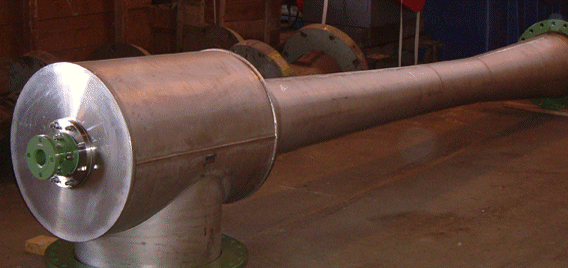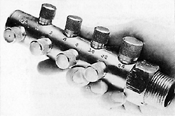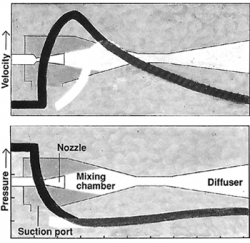Chemical and Process Engineering Resources

Steam
Motive steam plays probably the most important role in the operation of a steam jet ejector. Since internal dimensions are fixed, the ejector is designed for only one steam condition. When the steam condition changes there will be a change in the operation and efficiency of the ejector.
Besides wasting steam, excess motive pressure tends to choke the venturi with steam, thereby decreasing the suction capacity of the ejector. Note too that the performance of ejectors designed for saturated steam will be adversely affected if operated with super-heated steam.
The specific volume of steam increases with increasing temperature, which may require an increase in pressure to maintain required steam flow. Otherwise, as in the case of low steam pressure, the manufacturer must be consulted for a redesign of the ejectors.
Excess moisture in steam is one of the most common problems found in ejectors. Wet steam causes poor performance and, depending on the degree of wetness, can permanently damage an ejector in a very short period of time. A steam quality of less than 2% moisture is tolerable with most moderate vacuum systems. However, ejectors designed for a vacuum of 5 mm Hg abs or less should have steam that is completely dry or with a few degrees of superheat.
A telltale sign of wet steam is a fluttering needle on a steam pressure gage during operation. But the only sure way to determine quality of steam is to test it with a throttling calorimeter. This is a constant-enthalpy device that measures steam pressure and temperature. When used in combination with a Mollier chart, a reading of steam quality is obtained.
If steam is found to be wet, a steam separator should be installed in the steam line as close to the ejector as possible. Keeping all steam piping, and the steam separator, completely insulated will also help prevent the formation of wet steam.
Water
Multiple-stage ejector systems will normally include condensers between some or all stages. Condenser designs are based on maximum water temperature and available flow. When inlet water temperature increases above design maximum, loads to the following stage increase, resulting in a poorer vacuum at that stage. If the affected stage is the last (Z) stage, then the vacuums of all the preceding stages could also be affected.
The water temperature rise across a surface-contact condenser should be compared with design. A temperature rise larger or smaller than design could be an indication of a flow problem or fouling.In direct-contact condensers, high or low water flowrates can cause problems in the vacuum system. High water flow could flood the condenser, increasing pressure drop, and therefore, the back pressure on the stage discharging into it. Low water flow may not be distributed properly, allowing condensable load to bypass into the following ejector and resulting in a poor vacuum.
Process Loads
A change in process load will have a direct effect on the ejector system. Ejectors operate over a unique capacity curve, and any increase in load will result in a higher absolute pressure. An increase in noncondensables will travel through the system, affecting the following ejector stages. Discharge pressures of each stage will increase to the point of a breakdown in operation. As in the case of a changed steam condition, a change in process load will require redesign by the manufacturer, if design vacuum is to be maintained.
Check the Logs
Manufacturers' field service reports or process logs may offer clues to present operational problems. the symptoms of a vacuum problem may be similar to a past problem outlined, with solutions, in a service report. Process logs may also indicate problems with steam pressure or changes in process conditions that will have a direct effect on the vacuum system.
Now Look at the Process
If the preliminary checklist is completed with no obvious problems found, the next step is to determine whether the problem lies in the ejector system or the process. The steps remaining to be considered are: no-load vacuum test (single- or multistage) and an internal inspection.
The best way to determine if the vacuum problem lies in the ejector system or the process is to isolate and test the ejector separate from the process. The standard method of testing an ejector is to attach a blank, or blind flange, on the suction flange of the ejector and measure the vacuum at no-load conditions. A stable no-load vacuum is more difficult for an ejector to reach than a point under load conditions, simply because there is a greater suction-to-discharge pressure differential.
 |
| Figure 4: A Piccolo Gauge is Used to Check Vacuum Quality |
If the no-load vacuum measures the same as the manufacturer's test, then it is reasonably safe to assume that the ejector is working at its design load point. The problem may lie upstream from the suction of the ejector- possibly an increase in air leakage or process load. It should be noted that unless specified, an ejector may not have a stable vacuum at no-load even though it works at its design load.
To test an ejector at its design load point involves metering the design load into the suction of the ejector. Use a calibrated orifice or a series of orifices (such as can be found on an instrument known as a piccolo -- Figure 5), and then compare the measured vacuum to the design vacuum. A curve can be plotted and compared with the manufacturer's. This procedure should be considered only after all other tests are exhausted. (The manufacturer should be consulted for the proper field testing procedure if a test under design load conditions is desired.)
If the ejector does not obtain the manufacturer's tested no-load vacuum, the ejector should then be disassembled and internally inspected. No-load testing is easily accomplished on a single-stage ejector system, but a multistage ejector system must be evaluated by checking the last stage first.

 FB
FB


3 Comments
Excellent Article !
very informative article.. thnx
Additional information on the <air to steam mass ratio> for each pressure level or for a certain compression ratio would be greatly appreciated. There might be any calculation tool available on this subject, isn't it?
Tanks in advance.